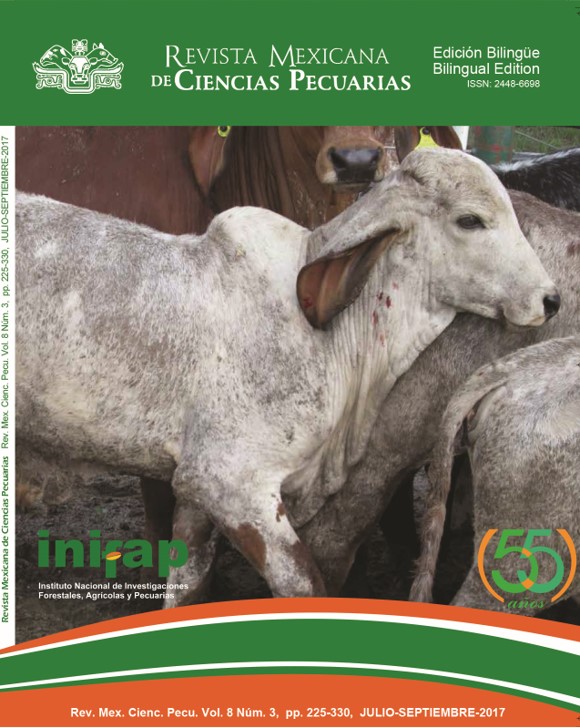Isolation of Erysipelothrix rhusiopathiae asociated with endocarditis in pigs in Guadalajara, Jalisco
DOI:
https://doi.org/10.22319/rmcp.v8i3.4511Keywords:
Erysipelothrix rhusiopathiae, Endocarditis, Arthritis, Septicemia, Pigs.Abstract
Erysipelothrix rhusiopathiae is the causative agent of swine erysipelas, a disease that causes significant economic losses in pig farms. In Mexico, the presence of this infection is unknown, mainly because the clinical form is accompanied by other pathogens. Furthermore, the isolation of the species is difficult due to the requirements of the bacteria. On a hog ranch in Guadalajara, cases of endocarditis, decreased production and observations of red spots on the skin of young animals and female broodstock were observed. Thus, the causative organism of these symptoms was sought. For the isolation of the bacterium were collected 8 samples of blood, 11 samples of heart, 6 samples of tonsils and 3 samples of synovial fluid of pigs of 7 mo of age and females’ broodstock. Blood samples were seeded in broth selective for Erysipelothrix. Organs were plated on blood agar and modified tryptone soy agar supplemented with horse serum. Five E. rhusiopathiae strains were isolated from the synovial fluid, hearts and tonsils and these were confirmed using API-Coryne system. These findings confirmed that E. rhusiopathiae caused endocarditis in swine in Guadalajara, Jalisco, Mexico and the necessity to determine its presence in pig farms in the country to know their epidemiological importance.
Downloads
References
Harada K, Uchiyama M, Hoshi T, Takahashi T. Comparison of three DNA extraction methods for detection of Erysipelothrix rhusiopathiae in chicken blood by polymerase chain reaction. J Vet Diagnost Invest 2009;(21):354-358.
Ingebritsona AL, Rothb JA, Hauerc PJ. Erysipelothrix rhusiopathiae: Association of Spa-type with serotype and role in protective immunity. Vaccine 2010;(20):2490-2496.
Shimoji Y, Yokomizo Y, Mori Y. Intracellular survival and replication of Erysipelothrix rhusiopathiae within murine macrophages: Failure of induction of the oxidative burst of macrophages. Infect Immun 1996;64(5):1789-1793.
Soto A, Zapardiel J, Soriano F. Evaluation of API Coryne system for identifying coryneform bacteria. J Clin Pathol 1994;(47):756-759.
Stackebrandt E, Reboli AC, Farrar WE. The genus Erysipelothrix. Prokaryotes 2006;(4):492-510.
Takahashi T, Sunama P, Satra J, Cholsindhu N, Kongthon S, Jitnupong W, et al. Serotyping and pathogenicity of Erysipelothrix strains isolated from tonsils of slaughter pigs in Thailand. J Vet Med Sci 1999;61(9):1007-1011.
Takeshi K, Makino S, Ikeda T, Takada N, Nakashiro A, Nakanishi K, et al. Direct and rapid detection by PCR of Erysipelothrix sp. DNAs prepared from bacterial strains and animal tissues. J Clin Microbiol 1999;37(12):4093-4098.
To H, Sato H, Tazumi A, Tsutsumi N, Nagai S, Iwata A, et al. Characterization of Erysipelothrix rhusiopathiae strains isolated from recent swine erisipelas outbreaks in Japan. J Vet Med Sci 2012;(74):949-953.
Restrepo-Salazar JG, Agudelo-López SP, Vélez-Aramburu E, Orrego-Cardona JC. Determinación de la seroprevalencia de Erisipela en cerdos de Lomarena - Bolívar mediante ELISA. CES Med Vet Zootec 2008;3(1):17-26.
To H, Nagai S. Genetic and antigenic diversity of the surface protective antigen proteins of Erysipelothrix rhusiopathiae. Clin Vacc Immunol 2007;(14):813-820.
Yamazaki Y. A multiplex polymerase chain reaction for discriminating from Erysipelothrix tonsillarum. J Vet Diagn Invest 2006;(18):384-387.
Downloads
Published
How to Cite
-
Abstract2439
-
PDF (Español)935
-
XML (Español)1475
Issue
Section
License

This work is licensed under a Creative Commons Attribution-NonCommercial-ShareAlike 4.0 International License.




